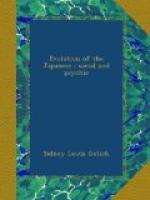In Shinto, sin is little, if anything, more than physical impurity. Although Buddhism brought a higher conception of religion for the initiated few, it gave no help to the ignorant multitudes, rather it riveted their superstitions upon them. It spoke of law indeed, and lust and sin; and of dreadful punishments for sin; but when it explained sin it made its nature too shallow, being merely the result of mental confusion; salvation, then, became simply intellectual enlightenment; it also made the consequences of sin too remote and the escape from them too easy. The doctrine of “Don,” suddenness of salvation, the many external and entirely formal rites, short pilgrimages to famous shrines, the visiting of some neighboring temple having miniature models of all the other efficacious shrines throughout the land, the wearing of charms, the buying of “o fuda,” and even the single utterance of certain magic prayers, were taught to be quite enough for the salvation of the common man from the worst of sins. Where release is so easily obtained, the estimate of the heinousness of sin is correspondingly slight. How different was the consciousness of sin and the conception of its nature developed by the Jewish worship with its system of sin offerings! Life for life. Whatever we may think of the efficacy of offering an animal as an expiation for sin, it certainly contributed far more toward deepening the sense of sin than the rites in common practice among the Buddhists. So far as I know, human or animal sacrifice has never been known in Japan.
In response to the not unlikely criticism that sacrifice is the result of profound sense of sin and not its cause, I reply that it is both. The profound sense is the experience of the few at the beginning; the practice educates the multitudes and begets that feeling in the nation.
Ceremonial purification is an old rite in Japan. In this connection we naturally think of the “Chozu-bachi” which may be found before every Shinto shrine, containing the “holy water” with which to rinse the mouth and wash the hands. Pilgrims and worshipers invariably make use of this water, wiping their hands on the towels provided for the purpose by the faithful. To our eyes, few customs in Japan are more conducive to the spread of impurity and infectious disease than this rite of ceremonial purification. No better means could be devised for the wide dissemination of the skin diseases which are so common. The reformed religion of New Japan—whether Buddhist, Shinto, or Christian—could do few better services for the people at large than by entering on a crusade against this religious rite. It could and should preach the doctrine that sin and defilement of the hearts are not removed by such an easy method as the rite implies and the masses believe. If retained as a symbol, the purification rite should at least be reformed as a practice.




